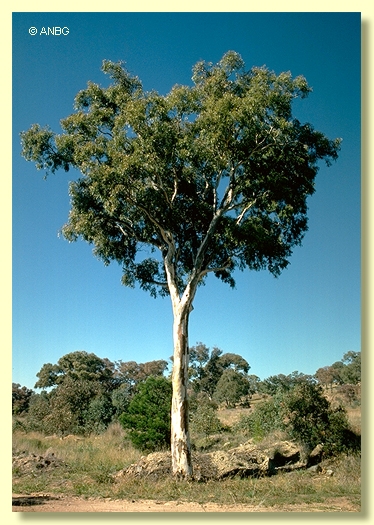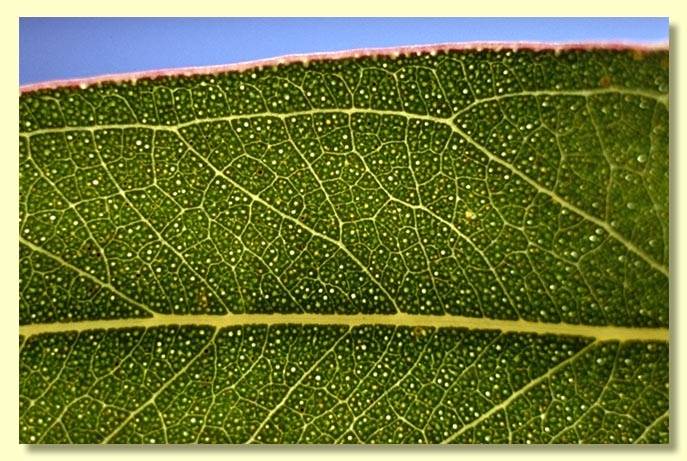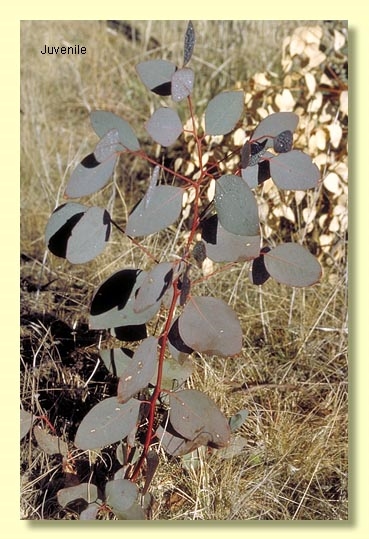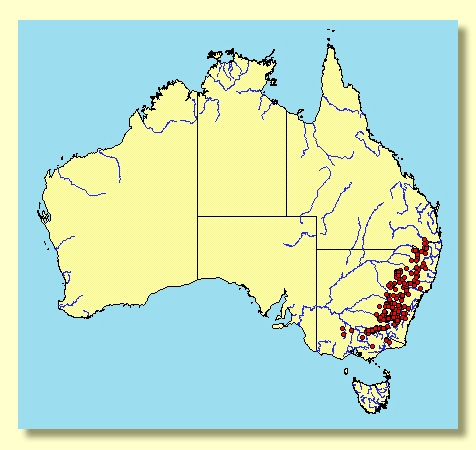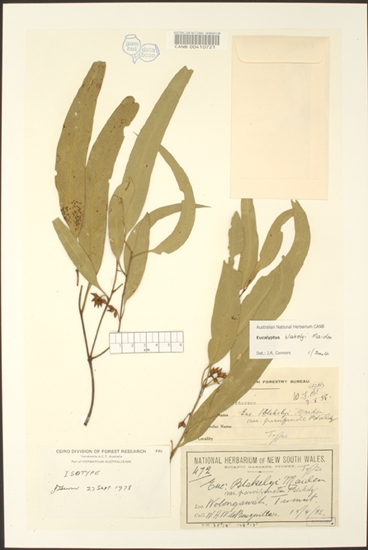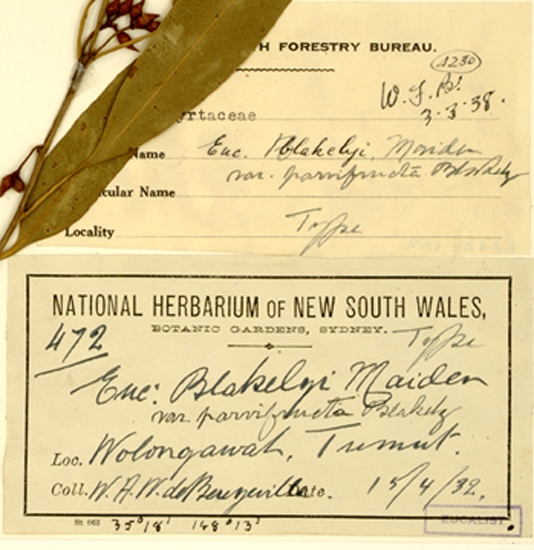Euclid - Online edition
Eucalyptus blakelyi
Eucalyptus | Symphyomyrtus | Exsertaria | Erythroxylon
T: Pilliga scrub, 10–15 miles [16–24 km] from Coonabarabran towards Rocky Glen, NSW, 11 Aug. 1911, H.I.Jensen 129; holo: NSW.
E. blakelyi var. irrorata Blakely, Key Eucalypts 131 (1934). T: numerous syntypes cited, e.g. Tambaroora, NSW, 1 Aug. 1911, R.H.Cambage 1786; syn: NSW.
E. blakelyi var. parvifructa Blakely, Key Eucalypts 132 (1934). T: Wollongawah near Tumut, NSW, 15 Apr. 1932, W.A.W. de Beuzeville s.n.; holo: NSW; iso: CANB.
Bark smooth throughout or with some loose rough grey bark at base of trunk, smooth bark pale grey, cream and white with patches of yellow, pink, brown or orange.
Juvenile growth (coppice or field seedlings to 50 cm): stem square in cross-section, sometimes prominently winged also, occasionally glaucous; juvenile leaves petiolate, opposite for a few pairs then alternate, usually ovate, 4–10 cm long, 3.3–7 cm wide, usually blue-green.
Adult leaves alternate, petiole 1–2.5 cm long; blade lanceolate or falcate, 6–20 cm long, 0.7–4.5 cm wide, base tapering to petiole, concolorous, glossy or dull, green to blue-green, side-veins greater than 45° to midrib, moderately to densely reticulate, intramarginal vein parallel to and well removed from margin, oil glands mostly island.
Inflorescence axillary unbranched, peduncles 0.5–1.9 cm long, buds 7 to ?15, pedicellate (pedicels 0.1–0.7 cm long). Mature buds narrowly ovoid to fusiform (0.8–1.4 cm long, 0.3–0.6 cm wide), green to creamy or glaucous, scar present, operculum conical to horn-shaped (0.5–1.1 cm long), stamens erect, anthers cuboid to oblong, versatile, dorsifixed, dehiscing by longitudinal slits (non-confluent), style long, stigma blunt, locules 3 or 4, the placentae each with 6 vertical ovule rows. Flowers white.
Fruit pedicellate (pedicels 0.1–0.7 cm long), hemispherical or truncate-globose, 0.2–0.5 cm long, 0.4–0.8 cm wide, disc raised and convex or oblique, or disc level, valves 3 or 4, strongly exserted.
Seeds black, brown or grey, 0.5–1.5 mm long, pyramidal or cuboid, dorsal surface pitted, hilum terminal.
Cultivated seedlings (measured at ca node 10): cotyledons reniform to oblong; stems square in cross-section, rarely glaucous; leaves always petiolate, opposite for 4 to 8 nodes then alternate, ovate to broadly so, 4.8–13 cm long, 2.5–7 cm wide, base tapering or truncate, green, blue-green or rarely glaucous.
Flowering has been recorded in October, November and December.
It has been used for fencing, firewood, gums, fuel and honey.
A small to medium-sized tableland red gum tree distributed from Victoria, where it occurs mainly north of the Great Dividing Range, through the tablelands of New South Wales to far south-eastern Queensland. It is often found in seasonally water-logged depressions, although in Victoria and southern New South Wales it also grows on stony rises. E. blakelyi is characterised by its smooth bark (sometimes with accumulated rough bark at the base), its buds with a long narrow acute operculum, its dull, broadly ovate to elliptical juvenile leaves and the black, toothed, single-coated seed.
Eucalyptus blakelyi belongs to the group of red gums which is distinguished by having buds with the stamens mostly erect, fruit where the disc is united to the ovary roof, and by the black, toothed, cuboid to pyramidal single-coated seed. Fifteen species belong to this group: E. amplifolia, E. blakelyi, E. chloroclada, E. dealbata, E. dwyeri, E. flindersii, E. gillenii, E. glaucina, E. infera, E. kabiana, E. nandewarica, E. nudicaulis, E. tereticornis, E. terrica and E. vicina.
E. blakelyi resembles E. tereticornis, which is notably a taller tree of more coastal habitats and has a slightly longer operculum swollen at the base. E. blakelyi is occasionally glaucous in the buds, showing its affinity with E. dealbata, which has a somewhat overlapping distribution but which occurs on stonier sites more on the western slopes of the tablelands in New South Wales and into southern Queensland. E. blakelyi sometimes intergrades with E. dealbata and E. dwyeri where distributions overlap. Both E. dwyeri and E. dealbata have a much shorter operculum than E. blakelyi. E. dwyeri can be further distinguished by having narrow juvenile leaves. E. amplifolia from the subcoastal and tableland areas of New South Wales extending just across the border into Queensland, differs by having larger orbicular to deltoid glossy juvenile leaves. (Juvenile leaves of E. blakelyi are normally ovate to orbicular and dull green to sometimes slightly glaucous.) Two other closely related species are E. chloroclada, from the western slopes and plains of New South Wales, from the Pilliga area northwards into the Texas, Cracow, Tambo, Dirranbandi area of south-east Queensland; and E. terrica, from the Inglewood and Warwick region of south-east Queensland. Both differ by normally having thin red-brown to brown rough bark on their trunk. However in some parts of Queensland, E. chloroclada can be smoothed-bark. In this situation, E. chloroclada can be separated by having the disc of the fruit flat or only slightly raised (usually steeply raised in E. blakelyi) and by having buds with a shorter operculum than E. blakelyi. On stony sites in far western New South Wales, north and west of the Lachlan River west almost to the River Darling is E. vicina. It has buds similar in shape to those of E. dealbata and E. dwyeri and all three are usually much shorter in the operculum length than E. blakelyi. E. nandewarica occurs in an enclave in foothills near Kaputar north-east of Coonabarabran and differs from E. blakelyi by the lower stature, narrowly lanceolate juvenile leaves and small buds (sometimes in threes) with inflexed stamens. E. glaucina, from the low coastal ranges and tablelands of central-northern New South Wales, differs marginally by having coarser buds and adult leaves. E. kabiana, from Mt Beerwah in the Glasshouse Mountains, differs by having lanceolate to broadly lanceolate, dull, grey-green juvenile leaves and buds with a longer narrow operculum like E. tereticornis. E. flindersii, from the slopes and summits of peaks in the Northern Flinders Range and some near-by areas of South Australia, has broadly ovate to ovate, dull, green to grey-green juvenile leaves and inflorescences which are commonly 3-budded in each umbel. E. gillenii, from the central and south-western part of central Australia, and E. nudicaulis, from the Mt Isa region in the north-western part of Queensland, are easily distinguished by having lanceolate juvenile leaves. E. infera, an odd eucalypt from the Warwick region in Queensland, has typical red gum buds and fruit but has juvenile leaves similar to the swamp gum E. camphora that are ovate to orbicular, with an emarginate apex and margins often with shallow crenulations.
Within its area of occurrence, E. blakelyi may be confused with other smooth-barked red gums from the series Liberivalvae, i.e. E. prava, E. parramattensis and E. seeana. E. blakelyi can be distinguished by having fruit with an ascending disc that is fused to the remains of the ovary roof, unlike the annular disc of series Liberivalvae that is free from the remains of the ovary roof.
MORE ABOUT RED GUMS AND OTHER ASSOCIATED GROUPS

